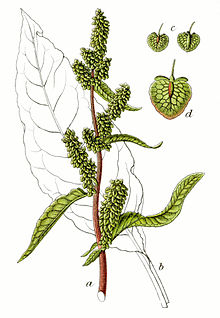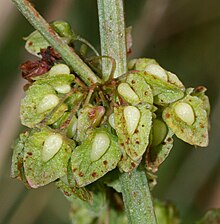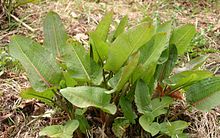Rumex
| Rumex | |
|---|---|

| |
| Patience dock (Rumex patientia) | |
| Scientific classification | |
| Kingdom: | Plantae |
| Clade: | Tracheophytes |
| Clade: | Angiosperms |
| Clade: | Eudicots |
| Order: | Caryophyllales |
| Family: | Polygonaceae |
| Subfamily: | Polygonoideae |
| Genus: | Rumex L. 1753 |
| Type species | |
| Rumex patientia L.
| |
| Species | |
| Synonyms | |
|
Lapathum Mill. | |
The docks and sorrels, genus Rumex L., are a genus of about 200 species of annual, biennial, and perennial herbs in the buckwheat family Polygonaceae.
Members of this family are very common perennial herbs growing mainly in the Northern Hemisphere, but various species have been introduced almost everywhere.
Some are nuisance weeds (and are sometimes called dockweed or dock weed), but some are grown for their edible leaves.
Rumex species are used as food plants by the larvae of a number of Lepidoptera species, and are the only host plants of Lycaena rubidus.[6]
Description
They are erect plants, usually with long taproots. The fleshy to leathery leaves form a basal rosette at the root. The basal leaves may be different from those near the inflorescence. They may or may not have stipules. Minor leaf veins occur. The leaf blade margins are entire or crenate.
The usually inconspicuous flowers are carried above the leaves in clusters. The fertile flowers are mostly hermaphrodites, or they may be functionally male or female. The flowers and seeds grow on long clusters at the top of a stalk emerging from the basal rosette; in many species, the flowers are green, but in some (such as sheep's sorrel, Rumex acetosella) the flowers and their stems may be brick-red. Each seed is a three-sided achene, often with a round tubercle on one or all three sides.
Uses
These plants have many uses. Broad-leaved dock (Rumex obtusifolius) used to be called butter dock because its large leaves were used to wrap and conserve butter.
Rumex hymenosepalus has been cultivated in the Southwestern US as a source of tannin (roots contain up to 25%), for use in leather tanning, while leaves and stems are used for a mordant-free mustard-colored dye.
These plants are edible. The leaves of most species contain oxalic acid and tannin, and many have astringent and slightly purgative qualities. Some species with particularly high levels of oxalic acid are called sorrels (including sheep's sorrel, Rumex acetosella, common sorrel, Rumex acetosa, and French sorrel, Rumex scutatus), and some of these are grown as leaf vegetables or garden herbs for their acidic taste.[7][8]
In Western Europe, dock leaves are a traditional remedy for the sting of nettles,[9][10] and suitable larger docks (such as broad-leaved dock R. obtusifolius or curled dock R. crispus) often grow conveniently in similar habitats to the common nettle (Urtica dioica).
In traditional Austrian medicine, R. alpinus leaves and roots have been used internally for treatment of viral infections.[11]
Rumex nepalensis is also has a variety of medicinal uses in the Greater Himalayas, including Sikkim in Northeastern India.[12]
Fossil record
Several fossil fruits of Rumex sp. have been described from middle Miocene strata of the Fasterholt area near Silkeborg in Central Jutland, Denmark.[13]
Species
- Rumex acetosa – sorrel, common sorrel, garden sorrel, narrow-leaved dock, spinach dock
- Rumex acetosella - sheep's sorrel, common sheep sorrel, field sorrel, red sorrel
- Rumex acetosella ssp. acetosella
- Rumex acetosella ssp. acetoselloides
- Rumex acetosella ssp. multifidus
- Rumex acetosella ssp. pyrenaicus - round-seeded sheep's sorrel
- Rumex × acutus - acute dock
- Rumex albescens - Oahu dock
- Rumex × alexidis - Alex's dock
- Rumex alpinus - alpine dock, monk's rhubarb
- Rumex altissimus - pale dock, smooth dock, peach-leaf dock
- Rumex andinus
- Rumex angiocarpus
- Rumex aquaticus L. – western dock, Scottish dock
- Rumex aquaticus ssp. aquaticus
- Rumex aquaticus ssp. arcticus - arctic dock
- Rumex aquaticus ssp. protractus
- Rumex aquaticus × longifolius
- Rumex aquitanicus
- Rumex arcticus
- Rumex arifolius - maiden sorrel, mountain dock
- Rumex azoricus
- Rumex balcanicus
- Rumex beringensis - Bering Sea dock
- Rumex brownii - Browne's dock
- Rumex brownii - swamp dock
- Rumex bucephalophorus - red dock
- Rumex bucephalophorus subsp. bucephalophorus
- Rumex bucephalophorus subsp. aegaeus
- Rumex bucephalophorus subsp. canariensis
- Rumex bucephalophorus subsp. gallicus
- Rumex bucephalophorus subsp. hispanicus
- Rumex bucephalophorus var. aegaeus
- Rumex bucephalophorus var. subaegaeus
- Rumex chrysocarpus - amamastla
- Rumex confertus Willd. – Asiatic dock
- Rumex × confusus - confused dock
- Rumex conglomeratus – clustered dock, sharp dock
- Rumex costaricensis

- Rumex crispus – curled dock, curly dock, yellow dock, sour dock, narrow dock, garden patience, narrow-leaved dock
- Rumex crispus subsp. crispus
- Rumex crispus subsp. littoreus
- Rumex crispus subsp. uliginosus
- Rumex crispus × confertus
- Rumex crispus × longifolius
- Rumex crispus × obtusifolius
- Rumex crispus × patientia
- Rumex crispus × pulcher
- Rumex cristatus : Greek dock
- Rumex cristatus subsp. cristatus
- Rumex cristatus subsp. kerneri
- Rumex crystallinus - shiny dock
- Rumex densiflorus - dense-flower or -flowered dock
- Rumex dentatus - toothed dock
- Rumex dentatus subsp. dentatus
- Rumex dentatus subsp. halacsyi
- Rumex dentatus subsp. reticulatus
- Rumex diclinis
- Rumex digynus
- Rumex dimidiatus
- Rumex dimorphophyllus
- Rumex × dissimilis - dock
- Rumex × dobrogensis
- Rumex × dolosus
- Rumex dregeanus
- Rumex drobovii
- Rumex drummondii
- Rumex × dufftii
- Rumex dumosiformis
- Rumex dumosus - wiry dock
- Rumex dumosus var. dumosus
- Rumex × dumulosus
- Rumex durispissimus
- Rumex ecklonianus
- Rumex ecuadoriensis
- Rumex elbrusensis
- Rumex ellenbeckii
- Rumex engelmanni
- Rumex ephedroides
- Rumex erosus
- Rumex × erubescens
- Rumex erythrocarpus
- Rumex esquirolii
- Rumex euxinus
- Rumex evenkiensis
- Rumex × exspectatus
- Rumex × fallacinus
- Rumex fascicularis
- Rumex fascilobus
- Rumex fenestratus subsp. puberulus
- Rumex fimbriatus
- Rumex × finitimus
- Rumex flexicaulis
- Rumex flexuosiformis
- Rumex flexuosus
- Rumex foliosus
- Rumex fontano-paludosus
- Rumex foveolatus
- Rumex × franktonis - Frankton dock
- Rumex fraternus
- Rumex fringillimontanus
- Rumex frutescens - wedgeleaf dock
- Rumex fueginus
- Rumex fueginus var. brachythrix
- Rumex fueginus var. ovato-cordatus
- Rumex fueginus var. tanythrix
- Rumex fueginus var. typicus
- Rumex gamsii
- Rumex gangotrianus
- Rumex gieshueblensis
- Rumex giganteus - Pawale
- Rumex ginii
- Rumex gmelini
- Rumex gmelinii var. latus
- Rumex gombae
- Rumex gracilescens
- Rumex gracilipes
- Rumex graminifolius - grassleaf sorrel
- Rumex granulosus
- Rumex × griffithii
- Rumex × grintzescui
- Rumex gussonii
- Rumex × gusuleacii
- Rumex hadmocarpus
- Rumex halophilus
- Rumex hararensis
- Rumex hasslerianus
- Rumex hastatulus - heartwing dock, heartwing sorrel
- Rumex hastatus
- Rumex hayekii
- Rumex hazslinszkyanus
- Rumex × heimerlii
- Rumex hellenicus
- Rumex henrardi
- Rumex hesperius
- Rumex × heteranthos
- Rumex heterophylus
- Rumex hexagynus
- Rumex hippiatricus
- Rumex hirsutus
- Rumex horizontalis
- Rumex hoschedei
- Rumex hostilis
- Rumex hultenii
- Rumex hungaricus
- Rumex × hybridus
- Rumex hydrolapathum - great water dock
- Rumex hymenosepalus - canaigre, canaigre dock
- Rumex × impurus
- Rumex inconspicuus
- Rumex integer
- Rumex integrifolia
- Rumex × intercedens
- Rumex intermedius
- Rumex intermedius ssp. algarbiensis
- Rumex intermedius ssp. lusitanicus
- Rumex interruptus
- Rumex × inundatus
- Rumex iseriensis
- Rumex jacutensis
- Rumex japonicus
- Rumex × johannis-moorei
- Rumex kamtshadalus
- Rumex kaschgaricus
- Rumex × kaschmirianus
- Rumex kerneri - Kerner's dock
- Rumex khekii
- Rumex × khorasanicus
- Rumex × knafii
- Rumex komarovii
- Rumex krausei - Krause's sorrel
- Rumex lachanus
- Rumex lacustris
- Rumex lanceolatus
- Rumex langloisii
- Rumex lanuginosus
- Rumex lapponicus
- Rumex lanuginosus
- Rumex latifolius
- Rumex lativalvis
- Rumex leptocaulis
- Rumex leptophyllus
- Rumex limoniastrum
- Rumex linearis
- Rumex × lingulatus
- Rumex litoralis
- Rumex lonaczewskii
- Rumex longifolius – dooryard dock, northern dock
- Rumex longisetus
- Rumex lorentzianus
- Rumex × lousleyi
- Rumex ludovicianus
- Rumex lugdunensis
- Rumex lunaria
- Rumex luxurians
- Rumex × lycheanus
- Rumex maderensis
- Rumex magellanicus
- Rumex magellanicus var. donatii
- Rumex magellanicus var. dusenii
- Rumex maritimus – golden dock, bristle dock, seashore dock
- Rumex marschallianus
- Rumex maximus
- Rumex megalophyllus
- Rumex meyeri
- Rumex × mezei
- Rumex microcarpus
- Rumex microdon
- Rumex × mirabilis
- Rumex mixtus
- Rumex moedlingensis
- Rumex × monistrolensis
- Rumex montanus
- Rumex monticola
- Rumex muelleri
- Rumex × munshii
- Rumex muretii
- Rumex muricatus
- Rumex × nankingensis
- Rumex natalensis
- Rumex neglectus
- Rumex nematopodus - Arizona dock
- Rumex nemorosus
- Rumex nepalensis
- Rumex nervosus
- Rumex nevadensis
- Rumex nigricans
- Rumex nikkoensis
- Rumex nivalis
- Rumex oblongifolius
- Rumex obovatus Danser – tropical dock

- Rumex obtusifolius – broad-leaved dock, bitter dock, bluntleaf dock, butter dock
- Rumex obtusifolius ssp. obtusifolius
- Rumex occidentalis
- Rumex occidentalis var. perplexus
- Rumex occultans
- Rumex ochotensis
- Rumex orbiculatus - great water dock
- Rumex orientalis
- Rumex orthoneurus - Chiricahua mountain dock
- Rumex × oryzetorum
- Rumex osswaldii
- Rumex oxysepalus
- Rumex × pakistanicus
- Rumex pallidus - seaside dock
- Rumex palustris – marsh dock
- Rumex × palustroides
- Rumex pamiricus
- Rumex × pannonicus
- Rumex papilio
- Rumex paraguayensis - Paraguayan dock
- Rumex patagonicus
- Rumex patientia – patience dock, garden patience, monk's rhubarb
- Rumex paucifolius - alpine sheep's sorrel, few-leaved dock, meadow dock
- Rumex peisonis
- Rumex peregrinus
- Rumex persicaris
- Rumex peruanus
- Rumex pictus
- Rumex pilatensis
- Rumex planivalvis
- Rumex polycarpus
- Rumex polygamus
- Rumex polyklonos
- Rumex polyrrhizus
- Rumex ponticus
- Rumex popovii
- Rumex praecox
- Rumex pratensis
- Rumex procerus
- Rumex × promiscuus
- Rumex × propinquus
- Rumex protractus
- Rumex pseudonatronatus - field dock
- Rumex × pseudopulcher
- Rumex pseudoscutatus
- Rumex pseudoxyria
- Rumex pulcher - fiddle dock
- Rumex pulcher ssp. divaricatus
- Rumex pulcher ssp. pulcher
- Rumex pulcher ssp. woodsii
- Rumex quarrei
- Rumex raulini
- Rumex rechingerianus
- Rumex rectinervius
- Rumex recurvatus
- Rumex × rhaeticus
- Rumex rhodesius
- Rumex × romanicus
- Rumex romassa
- Rumex × rosemurphyae
- Rumex roseus
- Rumex rossicus
- Rumex rothschildianus
- Rumex rupestris - shore dock
- Rumex ruwenzoriensis
- Rumex sagittatus - rambling dock
- Rumex × sagorski
- Rumex salicetorum
- Rumex salicifolius - willow dock, willow-leaved dock
- Rumex salicifolius ssp. angustivalvis
- Rumex salicifolius var. denticulatus
- Rumex salicifolius f. escallosus
- Rumex salicifolius ssp. montigenitus
- Rumex salicifolius var. nudivalvis
- Rumex salicifolius var. oreolapathum - willow dock
- Rumex salicifolius var. triangularis
- Rumex salicifolius var. trigranis
- Rumex salinus
- Rumex samuelssoni
- Rumex sanguineus L. – wood dock, redvein dock
- Rumex sanguineus var. sanguineus - bloody dock, blood dock, bloodwort, bloody wood dock[14]
- Rumex sanninensis
- Rumex schimperi
- Rumex schischkinii
- Rumex × schmidtii
- Rumex × schreberi
- Rumex × schultzei
- Rumex scutatus - French sorrel, leaf-shield sorrel
- Rumex scutatus ssp. gallaecicus
- Rumex sellowianus
- Rumex semigraecus
- Rumex shultzii
- Rumex sibiricus - Siberian dock
- Rumex similans
- Rumex × similatus
- Rumex simonkaianus
- Rumex simpliciflorus
- Rumex sinuatus
- Rumex × skofitzi
- Rumex skottsbergii - lava dock
- Rumex songaricus
- Rumex × sorkhabadensis
- Rumex spathulatus
- Rumex spiralis - winged dock
- Rumex spurius
- Rumex stenoglottis
- Rumex stenophyllus
- Rumex subalpinus - subalpine dock
- Rumex subarcticus
- Rumex × subdubius
- Rumex subrotundus
- Rumex subtrilobus
- Rumex subvirescens
- Rumex suffruticosus
- Rumex suzukianus
- Rumex sylvaticus
- Rumex sylvestris
- Rumex × talaricus
- Rumex tenax
- Rumex tenellus
- Rumex thyrsiflorus
- Rumex thyrsoides
- Rumex tianschanicus
- Rumex tibeticus
- Rumex tingitanus
- Rumex tmoleus
- Rumex toepffieri
- Rumex tolimensis
- Rumex tomentellus - willow creek dock
- Rumex × transbaicalicus
- Rumex triangularis
- Rumex triangulivalvis
- Rumex trifidus
- Rumex trinervius
- Rumex tuberosus
- Rumex tunetanus
- Rumex turcestanicus
- Rumex ucranicus
- Rumex × ujskensis
- Rumex × uludaghensis
- Rumex uncinulatus
- Rumex undulatus
- Rumex ursinus
- Rumex uruguayensis
- Rumex ussuriensis
- Rumex usticanus
- Rumex utahensis
- Rumex venosus - veiny dock or sand dock
- Rumex verrietianus
- Rumex verticillatus - swamp dock, water dock
- Rumex vesceritensis
- Rumex vesicarius - bladder dock
- Rumex violascens - violet dock
- Rumex wachteri
- Rumex × weberi
- Rumex × wildtianus
- Rumex woodii
- Rumex woodsii
- Rumex × wrightii
- Rumex × xenogenus
- Rumex yezoensis
- Rumex yungningensis
- Rumex zsakii
Nutrition
| Nutritional value per 100 g (3.5 oz) | |
|---|---|
| Energy | 92 kJ (22 kcal) |
3.2 g | |
| Dietary fiber | 2.9 g |
0.7 g | |
2 g | |
| Vitamins | Quantity %DV† |
| Vitamin A equiv. | 22% 200 μg |
| Thiamine (B1) | 3% 0.04 mg |
| Riboflavin (B2) | 8% 0.1 mg |
| Niacin (B3) | 3% 0.5 mg |
| Vitamin B6 | 7% 0.122 mg |
| Folate (B9) | 3% 13 μg |
| Vitamin C | 53% 48 mg |
| Minerals | Quantity %DV† |
| Calcium | 3% 44 mg |
| Iron | 13% 2.4 mg |
| Magnesium | 25% 103 mg |
| Manganese | 15% 0.349 mg |
| Phosphorus | 5% 63 mg |
| Potassium | 13% 390 mg |
| Zinc | 2% 0.2 mg |
| †Percentages estimated using US recommendations for adults,[15] except for potassium, which is estimated based on expert recommendation from the National Academies.[16] | |
See also
References
- ^ "Rumex". Index Nominum Genericorum. International Association for Plant Taxonomy. 2006-02-20. Retrieved 2008-07-01.
- ^ UniProt. "Taxonomy - Rumex (GENUS)". Retrieved 2008-07-01.
- ^ "Rumex graminifolius J.H. Rudolphi ex Lamb". Integrated Taxonomic Information System. Retrieved 1 July 2008.
- ^ "Rumex". International Plant Names Index (IPNI). Royal Botanic Gardens, Kew; Harvard University Herbaria & Libraries; Australian National Botanic Gardens. 2008-07-01.
- ^ Germplasm Resources Information Network (GRIN) (2005-08-04). "Genus: Rumex L." Taxonomy for Plants. USDA, ARS, National Genetic Resources Program, National Germplasm Resources Laboratory, Beltsville, Maryland. Retrieved 2008-07-02.
- ^ Warren, Andres; Harrera, Alfonso (15 March 2005). "Butterflies of Oregon Their Taxonomy, Distribution, and Biology" (PDF). Lepidoptera of North America. 6.
- ^ "Sorrel, Garden or Common [Rumex acetosa]". Botanical.com.
- ^ Łuczaj, Łukasz (2008). "Archival data on wild food plants used in Poland in 1948". Journal of Ethnobiology and Ethnomedicine. 4 (4). doi:10.1186/1746-4269-4-4. PMC 2275233. PMID 18218132.
{{cite journal}}: CS1 maint: unflagged free DOI (link) - ^ "Recorded uses of' dock (Rumex sp.)". Ethnomedica. Archived from the original on 2008-11-20. Retrieved 2008-04-15.
{{cite web}}: Unknown parameter|dead-url=ignored (|url-status=suggested) (help) - ^ "Be Nice to Nettles". Natural History Museum. 26 May 2006. Archived from the original on 2008-06-26.
{{cite web}}: Unknown parameter|dead-url=ignored (|url-status=suggested) (help) - ^ Vogl, S; Picker, P; Mihaly-Bison, J; Fakhrudin, N; et al. (2013). "Ethnopharmacological in vitro studieson Austria's folk medicine-An unexplored lore in vitro anti-inflammatory activities of 71 Austrian traditional herbal drugs". J Ethnopharmacol. 149 (3): 750–71. doi:10.1016/j.jep.2013.06.007. PMC 3791396. PMID 23770053.
- ^ O'Neill, Alexander R.; Badola, Hemant K.; Dhyani, Pitamber P.; Rana, Santosh K. (29 March 2017). "Integrating ethnobiological knowledge into biodiversity conservation in the Eastern Himalayas". Journal of Ethnobiology and Ethnomedicine. 13 (21). doi:10.1186/s13002-017-0148-9. Retrieved 2017-05-11.
{{cite journal}}: CS1 maint: unflagged free DOI (link) - ^ Friis, Else Marie (1985). "Angiosperm Fruits and Seeds from the Middle Miocene of Jutland (Denmark)". The Royal Danish Academy of Sciences and Letters. 24 (3).
- ^ "The Macabre Beauty of Bloody Dock". Paghat the Ratgirl.
- ^ United States Food and Drug Administration (2024). "Daily Value on the Nutrition and Supplement Facts Labels". Retrieved 2024-03-28.
- ^ National Academies of Sciences, Engineering, and Medicine; Health and Medicine Division; Food and Nutrition Board; Committee to Review the Dietary Reference Intakes for Sodium and Potassium (2019). Oria, Maria; Harrison, Meghan; Stallings, Virginia A. (eds.). Dietary Reference Intakes for Sodium and Potassium. The National Academies Collection: Reports funded by National Institutes of Health. Washington, DC: National Academies Press (US). ISBN 978-0-309-48834-1. PMID 30844154.
External links
- Rumex acetosella; Missouri Botanical Garden's efloras.org.
- Edibility of Dock: Identification and edible parts of Rumex spp.
- Video:- Dock (Rumex) As Wild Edible Food Part 1 | Frank Cook
- "Rumex". African Plants Database. Conservatoire et Jardin botaniques & South African National Biodiversity Institute. Retrieved 2018-07-05.
- Linnæi, Caroli (1753). "Trigynia". Species Plantarum, Exhibentes Plantas Rite Cognitas, ad Genera Relatas, cum Differenentiis Specificis, Nominibus Trivialibus, Synonymis Selectis, Locis Natalibus, Secundum System Sexuale Digestas. Retrieved 2008-07-02.
{{cite book}}: External link in|chapterurl=|chapterurl=ignored (|chapter-url=suggested) (help)
Rumex.
